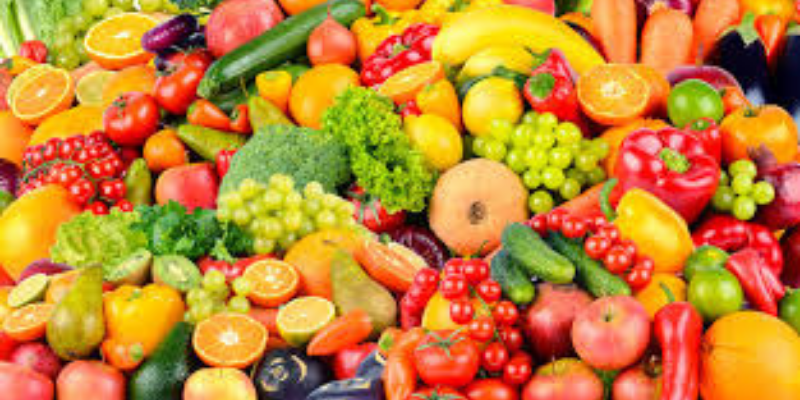Fruits and Vegetables Health Benefits: Learn How To Heal With Fruits and Vegetables

Fruits and Vegetables Health Benefits: Introduction
Governments and health officials recommend five to seven servings of fruits and vegetables per day. The reason for this is that in the wild, we would have survived primarily on fruits and vegetables, implying that we are designed to consume at least that much per day. This is why they contain so many essential vitamins, minerals and other nutrients for our health and well-being. We evolved together.
Each fruits and vegetables, on the other hand, has a unique set of benefits to offer and by picking and choosing which you eat, you can customize which benefits your body receives. Of course, some fruits and vegetables are far more beneficial than others. In this brief report, we’ll look at some of the most potent fruits and vegetables available.
Here are a few of the most potent ones:
Apples
The adage “an apple a day keeps the doctor away” is true, and while it’s probably not 100% effective, eating one every day will give you a massive health boost. They’re not only tasty and portable, but they’re also a great way to refresh yourself and are so high in vitamins that you can almost feel yourself getting healthier. There’s also a good selection of apples to choose from, whether green or red, granny smith or red delicious… there’s an apple for everyone!
Apples are also high in fiber, both soluble and insoluble. While soluble fiber (another example of soluble fiber is protein) helps prevent the buildup of cholesterol and the risk of heart disease, insoluble fiber will provide you with bulk in the intestinal and digestive tract, cleaning the system and allowing food to travel through it more quickly and efficiently.
Apples, like oranges, are known for their high vitamin C content, which helps the body fight illness by boosting the immune system and this is where the saying comes from, vitamin C is a great way to protect against colds, flu, and other viruses. Furthermore, because vitamin C is an antioxidant, it aids in the protection of cell walls against mutation.
Pears
A Pear is a delicious and soft fruit that is related to apples, as evidenced by the core that contains the seeds. They are high in vitamins and minerals such as thiamin, riboflavin, niacin, pantothenic acid, vitamin B6, folate, vitamin C, calcium, iron, magnesium, phosphorus, potassium and zinc. They not only have the benefits of vitamin C and fiber, but also of vitamin B6, which is a great energy booster used to improve the body’s utilization of carbohydrate energy.
Broccoli
When you’re told to eat your greens, broccoli is often one of the most common culprits, which is unfortunate given the numerous nutritional benefits it provides. It contains a lot of beta-carotene (which is converted into vitamin A) and vitamin C, as well as folic acid, calcium, and fiber.
It is especially important as a calcium source, containing nearly as much as a glass of milk, making it ideal for those who do not consume dairy. This promotes healthy nails and teeth as well as strong bones and connective tissue. It also improves contractions and fights high blood pressure and colon cancer.
Broccoli is a member of the cabbage family and shares many of the same health benefits as cabbage. As a cruciferous vegetable, it contains important phytochemicals known as indoles and isothiocyanates, which aid in cancer prevention.
They’re also high in iron, which is necessary for the transport of oxygen throughout the body because it’s the main component of haemoglobin and myoglobin (the red blood cells). This gives us oxidative energy and aids our bodies in delivering other essential nutrients.
Cabbage
This list would be incomplete if cabbage was not included, as it is one of the least calorific vegetables available. According to some claims, chewing cabbage burns more calories than eating it! As a result, it is a ‘negative calorie food’ and ideal for dieting.
Whether this is true or not, cabbage contains a high concentration of glutamine, an amino acid with anti-inflammatory properties. As a result, in ‘folk’ medicine, cabbage is wrapped around affected areas to treat inflammation, some even use it to treat sore breasts in breast-feeding mothers! It’s also high in calcium and iron, so you get all the mineral benefits without the calories.
Spinach
Saving the best for last, Spinach will instantly increase your biceps by up to 30% and help you save the day. If Popeye is to be believed. Actually, the rumor that spinach had such incredible health benefits stemmed from a misplaced decimal point, but that doesn’t mean they aren’t still extremely beneficial.
Spinach is high in calcium and one of the best sources of iron. Its iron content, as previously stated, is critical for assisting in the transport of oxygen and nutrients throughout the blood and is a key compound in red blood cells.
Iron, on the other hand, is beneficial for bone strength and muscle strength. Iron levels are frequently low in PMT women because it is lost in the blood. Look at your nail beds and under your lower eyelids for signs of low iron, if they are pale, you could benefit from some spinach! This iron, on the other hand, is non-heme iron, which means it works best when combined with vitamin C.
As a result, eat spinach alongside other vegetables or fruits. Spinach contains antioxidants as well as vitamins A, C, E and K, as well as magnesium, manganese, folate, iron, vitamin B2, calcium, potassium, vitamin B6, folic acid, copper, protein, phosphorus, zinc, niacin, selenium, omega-3 fatty acids and folic acid. That’s quite impressive. Stay strong until the end, and eat your spinach!
Black Chokeberry
Black chokeberry is another lesser known superfood that can help to improve digestion, protect against free radicals, aid in weight loss, improve eye health, fight cancer and repair the body, among other things. Yes, it’s yet another little known superfood that can help you feel and look better in a variety of ways.
To begin with, black chokeberries have an excellent calorie to nutrient ratio. They are high in dietary fiber, which aids digestion and bowel movements, and are low in fat and calories. They aid digestion because of the fiber content, which can sift through the bowels and intestinal systems, allowing everything to move freely.
Chokeberries contain a wide variety of antioxidants, including quercetin, epicatechin, caffeic acid, lutein and carotene. However, many of these incredibly beneficial nutrients also have a plethora of other beneficial effects throughout the body. Take Lutein, for example.
Recent studies have shown that this substance, which is also found in carrots, can help improve mitochondrial efficiency. Mitochondria are the energy factories of the cell that convert glucose into usable energy. When you improve the efficiency of your mitochondria, you will have more energy and will be less likely to gain weight.
When rats and mice were given lutein, it was discovered that they would voluntarily run much longer distances, burning far more calories than their non-lutein eating counterparts. Furthermore, lutein has recently been shown to be effective at increasing brain plasticity.
Lutein, in particular, aids in the formation of new neural connections, especially during a child’s formative years. This makes sense, given that lutein is also extremely beneficial to eye health and the eyes are frequently referred to as the only ‘exterior parts of the brain.’
Lutein, in particular, has been shown in studies to be effective in combating macular degeneration and thus ensuring good vision well into old age. Epicatechin is a compound that is equally impressive. This is also found in dark chocolate and apple juice and has a plethora of health benefits.
First and foremost, epicatechin is a vasodilator. That is, it will expand the veins and arteries, allowing a greater volume of blood to flow around the body with less effort.
This has been shown to significantly improve athletic performance as well as injury recovery because energy and nutrients are delivered to injuries more effectively. It may even improve brain function by assisting with the delivery of oxygen to the brain, it’s no surprise that eating right makes you sharper and more focused.
Epicatechin also increases nitric oxide (which causes vasodilation), which has additional benefits such as increased muscle satellite cell production. These aid in muscle growth and strength. We’ve only scratched the surface of what black chokeberry can do for you, so include it in your diet.
Prickly Pear Catcus
The prickly pear cactus is also known as opuntia, nopal and paddle cactus. As they say, a rose by any other name would smell as sweet! Whatever you call it, it’s a high-potassium, calcium, iron, vitamin C, beta carotene, and other nutrients.
This makes it a very nutritious food that may help to improve energy levels due to the iron content, which improves the formation of red blood cells, as well as the potassium content, which can help to reduce cramping and ensure the muscles function optimally.
Prickly pear cactus is also high in fiber and can help with digestion as well as creating a feeling of satiety so you don’t overeat. It’s also high in calcium, which helps to strengthen the bones but is less well known for its ability to improve tooth health, as well as to strengthen connective tissue (tendons and ligaments) and thus help prevent a variety of injuries.
Another little known advantage of calcium is its ability to strengthen contractions, which improves physical strength and athletic performance.
Rose Hip
While many of us are unfamiliar with rose hips, they were very popular during World War II when citrus fruits such as oranges were scarce. These are the cherry sized fruits that remain after the bloom has died.
They are extremely high in vitamin C, containing roughly four times as much as blackcurrants. This makes it an excellent source of antioxidants, and it is yet another item on this list that can protect your cells from the harmful effects of these highly reactive compounds.
You should never underestimate the importance of vitamin C rich foods. Vitamin C is well known for its ability to fight colds and strengthen the immune system, but its benefits extend much further.
For example, did you know that vitamin C is a precursor that the body uses to produce the ‘feel good hormone’ serotonin (which is then converted into the ‘sleep hormone’ melatonin)? As a result, vitamin C improves our mood while also improving our sleep and combating insomnia. And yes, vitamin C is an antioxidant and an excellent ingredient for immune system support.
Fruits and Vegetables Health Benefits: Conclusion
A plethora of studies have revealed that including more fruits and vegetables in a healthy diet helps protect the body against obesity, heart disease, type 2 diabetes, and even cancer.
According to research, you can’t eat too many raw fruits and vegetables, and you can’t get fat from them either. Your body requires the phytochemicals, antioxidants, vitamins, minerals, carbohydrates and protein found in fruits and vegetables, which are low in fat and calories with a few exceptions.
Eating more fruits and vegetables will help you lose weight, eliminate food cravings, clear up skin problems, think more clearly, and even overcome food addictions. More importantly, if you eat mostly plant based foods, you can practically guarantee that you will not have a heart attack.


